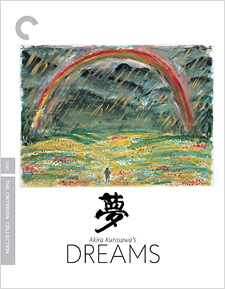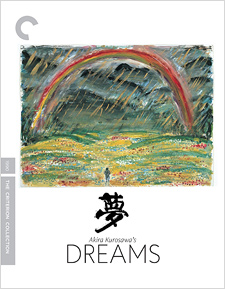Dreams, Akira Kurosawa’s (4K UHD Review)

Director
Akira KurosawaRelease Date(s)
1990 (August 8, 2023)Studio(s)
Kurosawa USA/Amblin/Warner Bros. (The Criterion Collection – Spine #842)- Film/Program Grade: B+
- Video Grade: A+
- Audio Grade: A
- Extras Grade: A
Review
Almost any way you approach it, Dreams is a singular entry in Akira Kurosawa’s overall filmography. For one thing, Kurosawa himself is its protagonist, the subjective “I” depicted at chronologically different ages over the course of the film. Made when he was 80 years old, it’s the first film that Kurosawa wrote entirely by himself. He also painted elaborate storyboards to aid in its staging and design, as he often did for his later work. Composed of a series of eight visually and thematically lyrical vignettes, the film lacks a narrative in the traditional sense. Instead, each episode is presented as an individual dream, all of them based upon Kurosawa’s own. As such, Dreams serves as a unique and highly-personal examination of specific issues of concern to the filmmaker, including the purpose of the individual, the nature of life and death, humanity’s relationship with the natural world, the unthinkable costs of warfare, and the danger of out-of-control technology.
The specific vignettes included here are Sunshine Through the Rain and The Peach Orchard (which deal with childhood), The Blizzard (a take on adolescence), The Tunnel (in which Kurosawa grapples with the aftermath of World War II and survivor’s guilt), Crows (a fanciful stroll through the paintings of Vincent van Gogh), Mount Fuji in Red and The Weeping Demon (commentaries on nuclear power, the former of which features special effects by Godzilla director Ishiro Honda), and Village of the Watermills (a vision of life less reliant on technology, more in harmony with nature). Two further vignettes were planned but later abandoned, including one about the seemingly universal dream of flight. Produced at a time when Kurosawa struggled to find financing in his own country, Dreams was ultimately made possible by the contributions of foreign admirers—including Francis Ford Coppola, George Lucas, and Steven Spielberg—as well as distribution by Warner Bros., which was then notable for its support of cinematic auteurs like Kurosawa and Stanley Kubrick.
While the completed film is admittedly self-indulgent, its power arises from both its poetic presentation and stunning artistry. Simply put, Dreams is a pure visual marvel from start to finish. Whereas many of his earlier films were shot in the wider scope aspect ratio, Kurosawa chose to employ the more intimate 1.85:1 format for this film. Yet every inch of the widescreen frame is used to full advantage. The film’s stunning landscape photography combines with special effects by Lucas’s Industrial Light and Magic to produce a visual symphony of light, color, and movement. Case in point: Crows, in which a young Japanese artist stares in awe at the work of van Gogh in a museum gallery... and then walks straight into the paintings! Wandering through these vibrantly-rendered landscapes, he eventually encounters the master himself, played by no less than director Martin Scorsese, who was also a friend and admirer.
Dreams was shot by on 35 mm photochemical film by cinematographers Takao Saito and Shoji Ueda using Panavision cameras and spherical lenses. For its release on Ultra HD, Criterion has completed a new digital restoration and high dynamic range grade (HDR10 only) of the same 4K negative scan that was used to produce their 2016 Blu-ray release, a process that was supervised by Ueda. The presentation has also been encoded on a 100 GB disc for maximum quality, with data rates averaging 90 Mbps. Contrast is superb, with inky blacks, bold highlights, wonderful texturing, and absolutely exquisite detail. Colors are richly saturated and they’re accurate—which cinephiles will know is particularly important for this film. The Peach Orchard is truly something to behold here, with vivid hues throughout. The expanded contrast offers real benefit to the mist-infused forest atmospherics of Sunshine Through the Rain, the deathly-still, frozen mountainside of The Blizzard, and the deep shadows of The Tunnel. The bold colors apparent in Crows abound with subtle nuance and shadings. And the quiet natural beauty of Village of the Watermills is greatly enhanced too in HDR10. Best of all, a light-moderate but ever organic wash of film grain remains in evidence at all times. Honestly, it’s hard to imagine that Dreams has ever looked this good before outside of its earliest theatrical screenings.
The film’s soundtrack is included in remastered lossless Japanese 2.0 surround in DTS-HD Master Audio format, the same mix found on the previous Blu-ray. The track is clean and clear, completely lacking in hiss, pops, or other age-related artifacts that may have been present in the original 35 mm mag source. The soundstage is full and surprisingly wide. Optional English subtitles are available in a careful translation that best represents Kurosawa’s original dialogue.
Criterion’s new Ultra HD release is a 2-disc set that includes the film in 4K on UHD and 1080p HD on Blu-ray (the same disc released in 2016 and reviewed here on The Bits). Both discs include the following special feature:
- Audio Commentary by Stephen Prince
To this, the Blu-ray adds the following:
- Making of Dreams (SD – 150:39)
- Kurosawa’s Way (HD – 52:10)
- Teruyo Nogami (HD – 17:23)
- Takashi Koizumi (HD – 16:03)
- US Theatrical Trailer (SD – 1:47)
The audio commentary was recorded for the previous Blu-ray. It features film scholar Stephen Prince (author of The Warrior’s Camera: The Cinema of Akira Kurosawa) who provides a plethora of trivia, historical context, production anecdotes, and other information about both the film and its maker. Next up is a feature-length documentary, The Making of Dreams (150:39), directed by Nobuhiko Obayashi (House) and shot during the production of the film. It was originally produced on SD 4x3 video, so the visual quality is low, yet the intellectual content is high indeed. You also get the 2011 documentary Kurosawa’s Way directed by the filmmaker’s longtime translator, Catherine Cadou. This is fascinating, because she interviews eleven major international directors on the many ways in which Kurosawa’s work has influenced their own. There a pair of interviews, one with Kurosawa’s longtime script supervisor, Teruyo Nogami, and one with assistant director Takashi Koizumi. Finally, the film’s US theatrical trailer is included. Other than The Making of Dreams and the trailer (which was upsampled from SD), all of this material is in full HD. In the packaging, you also get a booklet with an essay by film critic Bilge Ebiri, and Kurosawa’s own script for an unfilmed ninth dream with text introduction by Nogami.
Drawing inspiration from theatre, art, literature, classical music, and more, Akira Kurosawa’s Dreams is an uneven but utterly fascinating film. Its vignettes range in tone, starting with the curious and introspective, passing through sheer wonder, anguish, outrage, and even horror, and finally returning to the peaceful and wise, taking the audience on a complete intellectual and emotional journey in the process. While it’s certainly not a film to be watched casually, Dreams is a dazzling experience. And while Kurosawa would follow it with two more projects before his death in 1998—Rhapsody in August (1991) and Madadayo (1993)—Dreams remains the single most personally-revealing work of his long career. Cinephiles will be pleased to learn that Criterion’s 4K Ultra HD upgrade is magnificent, and the new definitive way to experience this film at home. Highly recommended!
- Bill Hunt
(You can follow Bill on social media on Twitter and Facebook)

